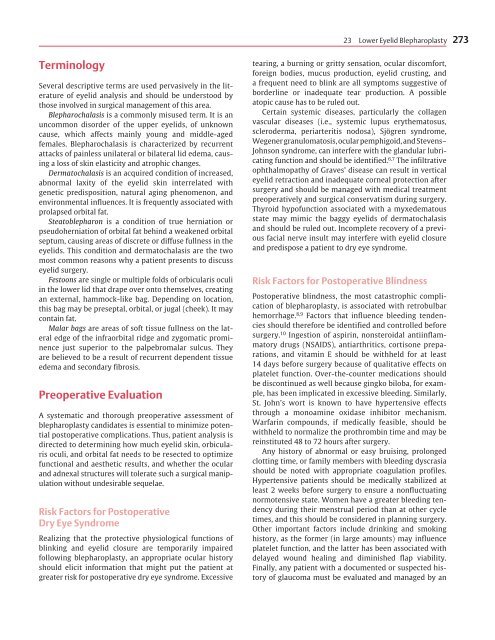23 Lower Eyelid Blepharoplasty - Facial plastic surgeon in San Diego
23 Lower Eyelid Blepharoplasty - Facial plastic surgeon in San Diego
23 Lower Eyelid Blepharoplasty - Facial plastic surgeon in San Diego
You also want an ePaper? Increase the reach of your titles
YUMPU automatically turns print PDFs into web optimized ePapers that Google loves.
<strong>23</strong> <strong>Lower</strong> <strong>Eyelid</strong> <strong>Blepharoplasty</strong> 273Term<strong>in</strong>ologySeveral descriptive terms are used pervasively <strong>in</strong> the literatureof eyelid analysis and should be understood bythose <strong>in</strong>volved <strong>in</strong> surgical management of this area.Blepharochalasis is a commonly misused term. It is anuncommon disorder of the upper eyelids, of unknowncause, which affects ma<strong>in</strong>ly young and middle-agedfemales. Blepharochalasis is characterized by recurrentattacks of pa<strong>in</strong>less unilateral or bilateral lid edema, caus<strong>in</strong>ga loss of sk<strong>in</strong> elasticity and atrophic changes.Dermatochalasis is an acquired condition of <strong>in</strong>creased,abnormal laxity of the eyelid sk<strong>in</strong> <strong>in</strong>terrelated withgenetic predisposition, natural ag<strong>in</strong>g phenomenon, andenvironmental <strong>in</strong>fluences. It is frequently associated withprolapsed orbital fat.Steatoblepharon is a condition of true herniation orpseudoherniation of orbital fat beh<strong>in</strong>d a weakened orbitalseptum, caus<strong>in</strong>g areas of discrete or diffuse fullness <strong>in</strong> theeyelids. This condition and dermatochalasis are the twomost common reasons why a patient presents to discusseyelid surgery.Festoons are s<strong>in</strong>gle or multiple folds of orbicularis oculi<strong>in</strong> the lower lid that drape over onto themselves, creat<strong>in</strong>gan external, hammock-like bag. Depend<strong>in</strong>g on location,this bag may be preseptal, orbital, or jugal (cheek). It mayconta<strong>in</strong> fat.Malar bags are areas of soft tissue fullness on the lateraledge of the <strong>in</strong>fraorbital ridge and zygomatic prom<strong>in</strong>encejust superior to the palpebromalar sulcus. Theyare believed to be a result of recurrent dependent tissueedema and secondary fibrosis.Preoperative EvaluationA systematic and thorough preoperative assessment ofblepharoplasty candidates is essential to m<strong>in</strong>imize potentialpostoperative complications. Thus, patient analysis isdirected to determ<strong>in</strong><strong>in</strong>g how much eyelid sk<strong>in</strong>, orbicularisoculi, and orbital fat needs to be resected to optimizefunctional and aesthetic results, and whether the ocularand adnexal structures will tolerate such a surgical manipulationwithout undesirable sequelae.Risk Factors for PostoperativeDry Eye SyndromeRealiz<strong>in</strong>g that the protective physiological functions ofbl<strong>in</strong>k<strong>in</strong>g and eyelid closure are temporarily impairedfollow<strong>in</strong>g blepharoplasty, an appropriate ocular historyshould elicit <strong>in</strong>formation that might put the patient atgreater risk for postoperative dry eye syndrome. Excessivetear<strong>in</strong>g, a burn<strong>in</strong>g or gritty sensation, ocular discomfort,foreign bodies, mucus production, eyelid crust<strong>in</strong>g, anda frequent need to bl<strong>in</strong>k are all symptoms suggestive ofborderl<strong>in</strong>e or <strong>in</strong>adequate tear production. A possibleatopic cause has to be ruled out.Certa<strong>in</strong> systemic diseases, particularly the collagenvascular diseases (i.e., systemic lupus erythematosus,scleroderma, periarteritis nodosa), Sjögren syndrome,Wegener granulomatosis, ocular pemphigoid, and Stevens–Johnson syndrome, can <strong>in</strong>terfere with the glandular lubricat<strong>in</strong>gfunction and should be identified. 6,7 The <strong>in</strong>filtrativeophthalmopathy of Graves’ disease can result <strong>in</strong> verticaleyelid retraction and <strong>in</strong>adequate corneal protection aftersurgery and should be managed with medical treatmentpreoperatively and surgical conservatism dur<strong>in</strong>g surgery.Thyroid hypofunction associated with a myxedematousstate may mimic the baggy eyelids of dermatochalasisand should be ruled out. Incomplete recovery of a previousfacial nerve <strong>in</strong>sult may <strong>in</strong>terfere with eyelid closureand predispose a patient to dry eye syndrome.Risk Factors for Postoperative Bl<strong>in</strong>dnessPostoperative bl<strong>in</strong>dness, the most catastrophic complicationof blepharoplasty, is associated with retrobulbarhemorrhage. 8,9 Factors that <strong>in</strong>fluence bleed<strong>in</strong>g tendenciesshould therefore be identified and controlled beforesurgery. 10 Ingestion of aspir<strong>in</strong>, nonsteroidal anti<strong>in</strong>flammatorydrugs (NSAIDS), antiarthritics, cortisone preparations,and vitam<strong>in</strong> E should be withheld for at least14 days before surgery because of qualitative effects onplatelet function. Over-the-counter medications shouldbe discont<strong>in</strong>ued as well because g<strong>in</strong>gko biloba, for example,has been implicated <strong>in</strong> excessive bleed<strong>in</strong>g. Similarly,St. John’s wort is known to have hypertensive effectsthrough a monoam<strong>in</strong>e oxidase <strong>in</strong>hibitor mechanism.Warfar<strong>in</strong> compounds, if medically feasible, should bewithheld to normalize the prothromb<strong>in</strong> time and may bere<strong>in</strong>stituted 48 to 72 hours after surgery.Any history of abnormal or easy bruis<strong>in</strong>g, prolongedclott<strong>in</strong>g time, or family members with bleed<strong>in</strong>g dyscrasiashould be noted with appropriate coagulation profiles.Hypertensive patients should be medically stabilized atleast 2 weeks before surgery to ensure a nonfluctuat<strong>in</strong>gnormotensive state. Women have a greater bleed<strong>in</strong>g tendencydur<strong>in</strong>g their menstrual period than at other cycletimes, and this should be considered <strong>in</strong> plann<strong>in</strong>g surgery.Other important factors <strong>in</strong>clude dr<strong>in</strong>k<strong>in</strong>g and smok<strong>in</strong>ghistory, as the former (<strong>in</strong> large amounts) may <strong>in</strong>fluenceplatelet function, and the latter has been associated withdelayed wound heal<strong>in</strong>g and dim<strong>in</strong>ished flap viability.F<strong>in</strong>ally, any patient with a documented or suspected historyof glaucoma must be evaluated and managed by an


